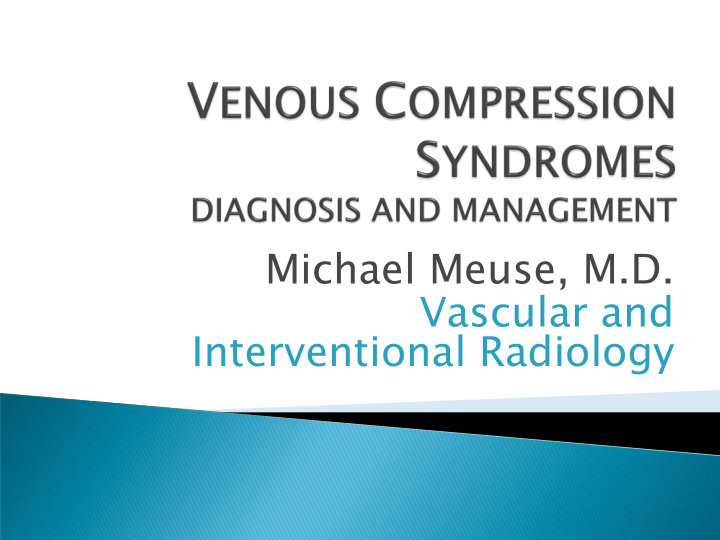



Michael Meuse, M.D. Vascular and Interventional Radiology
Iliac Vein Compression Syndrome ◦ Left CIV compressed by right CIA ◦ Virchow 1851: DVT L>R ◦ May and Thurner 1954: venous “spurs” ◦ Cockett and Thomas 1965: iliocaval compression Primary Axillosubclavian Vein Thrombosis ◦ Activity- induced thrombosis (“Effort” Thrombosis) ◦ Paget (1875), von Schroetter (1884) Paget-Schroetter Syndrome, ◦ Compression at thoracic inlet (TOS)
LCIV compressed between RCIA/spine Chronic irritation-->endothelial proliferation
Typically young women Following period of inactivity ◦ e.g. surgery, pregnancy, illness Acute: Iliofemoral DVT ◦ Swelling, pain, erythema ◦ Phlegmasia cerulea dolens Chronic: venous stasis, chronic DVT ◦ Swelling, pain, venous claudication ◦ varicose veins, skin changes
H&P key to diagnosis Classic venographic findings With DVT ◦ Acute: lesion unmasked by thrombolysis ◦ Chronic: R/O other causes of iliac vein occlusion Without DVT ◦ Venogram ◦ Typical symptomatology
Duplex Ultrasound ◦ Reliable diagnosis of femoropopliteal DVT ◦ non-phasic signal obstruction ◦ evaluation of reflux Magnetic Resonance Imaging ◦ Diagnosis of iliofemoral DVT with MRV ◦ Cross-sectional images - CIV compression Impedance/Strain-gauge/Air Plethysmography ◦ diagnosis of DVT ◦ Maximal Venous Outflow - CVI
Ascending Venography ◦ Gold standard for diagnosis of iliofemoral DVT ◦ Depicts CIV compression and collaterals Intravascular Ultrasound (IVUS) ◦ Depicts vein “spurs”, clot ◦ Accurate measurement of vessel diameter Intravascular Manometry ◦ > 3 mm Hg probably significant
Chronic Venous Insufficiency ◦ valvular incompetence 2° to dilation/destruction ◦ PTS in 2/3 of patients despite anticoagulation ◦ Strandness et al (JAMA 1983), 39 month f/u pain and swelling 67 % pigmentation 23 % ulceration 5 % Socioeconomic effects ◦ health care costs ◦ occupational disability
Conservative ◦ anticoagulation ◦ compression stockings Surgical ◦ cross-femoral saphenous vein bypass with AVF ◦ venotomy/transposition with CIA sling/bridge ◦ RCIA transposition w/wo interposition graft Percutaneous/endovascular ◦ thrombolysis ◦ stent placement
Access site (US guided) ◦ Popliteal/post. tib. vein if iliofemoral DVT present ◦ CFV if no DVT present Mechanical thrombectomy ◦ Debulking exposure of clot to lytic agent ◦ rate of lysis ◦ Lytic agent via multi-sidehole catheter Check progress venographically every 12 hrs
Self expanding stent Technical Success ◦ Venographic flow ◦ Pressure gradient < 2mm Hg ◦ IVUS
Post-procedure ◦ Clopidogrel bisulfate (Plavix) 4-6 wks ◦ Warfarin sodium (Coumadin) for DVT 3-6 mons Follow up ◦ Clinical/Duplex ◦ Venogram/IVUS for recurrent/persistent symptoms ◦ Reintervention if required (PTA/Stenting)
MAY-THURNER SYNDROME
COMPLETION DSA
Tech Clin 1-3 year n success success patency 8 100% 100% 100% Binkert (1998) O’Sullivan (1999) 35 87% 85% 92% 10 100% 100% 90% Patel (2000) 17 100% 94% 79% Hurst (2001)
Synonyms: ◦ Primary axillosubclavian vein thrombosis ◦ Effort vein thrombosis >90% AS thrombosis are secondary Thoracic Outlet Syndrome (TOS) ◦ Most pts. have neurologic and/or arterial symptoms ◦ 2-10% have symptomatic venous obstruction ◦ compression of neurovascular bundle by clavicle, 1st rib, scalenus muscles (+cervical rib, ligaments)
Acute ◦ Young patient with acute AS thrombosis following strenuous exercise ◦ Average age 34 years, M > F, R > L ◦ Pain, swelling, venous engorgement, cyanosis ◦ phlegmasia cerulea dolens Chronic (less common) ◦ symptoms of venous stasis If untreated 75% develop permanent disability Small but not insignificant rate of PE
H&P is key Axillosubclavian vein thrombosis R/O other causes of thrombosis ◦ central venous catheter ◦ malignancy ◦ trauma ◦ coagulopathy arterial/neurogenic symptoms may suggest classic TOS
Duplex Ultrasound ◦ diagnosis of DVT Conventional Venography ◦ gold standard: DVT & collaterals ◦ typical lesion unmasked following thrombolysis MRV/MRI ◦ demonstrates DVT and surrounding soft tissue ◦ parasagittal images may show SV compression IVUS ◦ venous abnormalities, clot
Images courtesy of Daniel Sze, M.D.
Images courtesy of Daniel Sze, M.D.
IVUS
Catheter-directed thrombolysis ◦ Access via basilic or brachial vein ◦ Lytic agent infused via multi-sidehole catheter ◦ Additional mechanical thrombectomy ◦ Recanalization/limited PTA (poss. rethrombosis) Anticoagulation for approx. 1-6 months ◦ Resolution of phlebitis ◦ Ptn. may become asymptomatic collaterals ◦ Duration of anticoagulation controversial
Surgical decompression ◦ 1st/cervial rib resection, medial clavicle resection ◦ Subclavius/scalenus muscle division/resection ◦ Supra/sub clavicular or transaxillary approaches ◦ Ideal method controversial Repeat venogram ◦ PTA of residual stenoses ◦ Limited role for stents
VENOGRAPHY THROMBOSIS COMPRESSION THROMBOLYSIS ANTICOAGULATION EVALUATION SYMPTOMATIC / ABNORMALITY ASYMPTOMATIC / NO ABNORMALITY RIB RESECTION VENOGRAM RESIDUAL STENOSIS NORMAL VEIN PTA
N LYSIS SURGERY PTA/STENT F/U** • Machleder 1993 50 20/24 36 9/0 83%/38m • Adelman 1995 18 1217 11 0/0 100%/21m • Beygui 1997 13 9/13 8 0/0 na • Sheeran 1997 14 13/14 8 2/0 57%/24m • Lee 1998 11 9/11 11 0/0 81%/na • Urschel 2000 241 239/241 241* 0/0 89%/na • Feugier 2001 10 3/7 10* 0/0 80%/45m • Kreienberg 2001 23 23/23 23* 23/14 74%/48m • Coletta 2001 19 /18 18* 2/6 89%/38m • Angle 2001 18 17/18 18* 5/0 100%/na *early surgical decompression without interval anticoagulation **asymptomatic/mean follow-up
Early and complete thrombolysis Limited PTA prior to surgery Staged vs. early surgical decompression Method and approach of surgery Staged stress venogram following surgery with possible PTA (avoid stenting if possible) Anticoagulation vs. no anticoagulation following surgery
H&P key to diagnosing iliac vein and thoracic outlet venous compression syndromes US, MRV, IVUS, Venography useful for confirming diagnosis and planning therapy Aggressive management can prevent long-term sequelae of DVT and avoid disability Good mid-term results with endovascular treatment of iliac vein compression syndrome Good long-term results with multidisciplinary management of Effort thrombosis
Recommend
More recommend